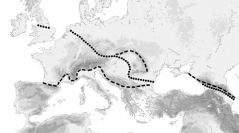

 Comptes Rendus Palevol
17 (4-5) - Pages 276-286
Comptes Rendus Palevol
17 (4-5) - Pages 276-286A multivariate cluster analysis of western Eurasian regional herbivorous mammalian faunas is applied in order to reveal the paleobiogeographic context of early human dispersal in the area under study. During the early Pleistocene, the North Mediterranean area and Caucasian Land acted as refugia for warm-loving Pliocene faunal holdovers. The Italian Peninsula was biogeographically partially isolated during most of the early Pleistocene due to the forested Dinaric Alps zoogeographic filter, which possibly caused the late arrival of hominines on the Italian Peninsula. A multivariate analysis confirms a firm paleobiogeographic border between the Iberian Peninsula and northwestern Africa. The Pannonian–western European path is proposed here as the most plausible dispersal route for early hominines. The article gives a brief discussion of paleobiogeographic significance of the Alpine-Himalayan Mountain Belt and the Movius Line in western Eurasia.
Early Pleistocene, Western Eurasia, Herbivores, Human dispersal, Paleobiogeography, Homo ex gr. erectus